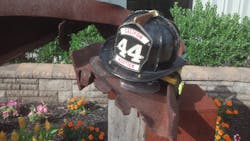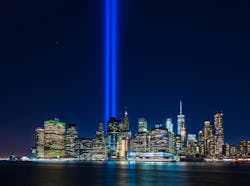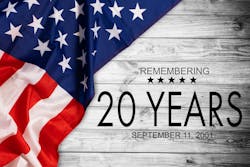When the first plane hit Tower 1, it felt like I was on one of those old carnival rides where you climb in a swinging cage and attempt to go completely around — only to not quite make it over, and you swing back in the other direction.
After we got off the floor from being knocked over, the lights flashed off and then came back on. The sounds of the fire alarm could be heard above the noise of the servers in the data center we were in. I looked out the window at the bright blue sky, and I could see papers floating everywhere like confetti, and glass, metal, debris, and a body fell downward from the sky. My first thought was that the top of the building blew from a bomb or something. We made our way to the A stairwell and took our places in the mass exodus of people heading down the steps. It was surprisingly quiet — like everyone was either in shock, or perhaps there just weren’t words that could express what was happening.
As people from lower floors entered the stairwell, there were some rumors being passed that an airplane had hit the Tower — no word on how big. So I was quick to assume it was a small single-engine plane with a pilot that failed to steer around the Tower and hit it.
As we got lower, I began to see companies of firefighters making the climb upward carrying high-rise packs and spare bottles. They stayed to the outside of the stairwell, and we stayed to the inside. The look on their faces was one of horror, as if they were climbing into their worst nightmare. I remember a few people trying to pass me on my right. When I turned to ask them to stay to the inside, I saw a tall man who was completely blackened except for the whites of his eyeballs and a woman whose dress had completely melted to her skin. I don’t know if the words ever came out. Someone said they had come from the 78th floor.
I eventually lost the two men I was with and found myself at the Mezzanine level where the floor was flooding, and I carried a woman across the water and to a dry spot. As I walked into the Mezzanine, a path I’d walked down hundreds of times, I noticed it was different now. It was dim, and the windows were covered with a splattering of something. For a moment, I was completely alone looking out of the two-story-high windows, and my eyes began to focus on what I was seeing. The windows were splattered red from blood.
I made my way to the outside doors to go across to the next building, and a man in uniform stopped me. He stepped inside for a moment as a body came crashing to the ground, and then he told me to run across to the next building. I followed the trails of blood on the floor, and eventually found my way outside again at the Marina by the Winter Garden. I now had a full view of what was happening in the Twin Towers. A NYPD helicopter flew overhead to try and rescue people from the rooftops, but the smoke and heat were too intense to get close enough. People had broken out windows and stood on ledges screaming for help that would never come. As the fires got closer to them, they would make the choice to jump rather than burn.
There was a group of 10 or so people on the same floor, all outside on the edge of the building. The intense fire and smoke was working its way downward toward them, until it was directly above them. The heat must have become too much, so one at a time, they jumped. I was sickened, but could not look away. Eventually I remember there was only one man and one woman left. They stood side by side, held hands, and together they jumped.
You’re probably asking yourself, “Why am I reading a 9/11 story in EC&M”? The answer is: Electricians were there.
On that morning, I was given a new partner for the day, and we went over to Tower 1 from the Amex Tower to do a small job on the 39th floor. Once we completed it, we headed for the elevators to go upstairs and grab a cup of coffee. My pager went off, and we returned to the data center so I could make a call that would save our lives. Had we been in the elevator at that moment, we would have been incinerated by the fires rolling down the elevator shafts. We never did get that cup of coffee.
A total of 21 brother electricians lost their lives that day. At least another 20 died from related injuries. Thousands more have been affected with either short- or long-term illnesses. For them, life is a struggle every single day. You didn’t have to be there in the buildings or chaos to get sick physically or mentally. Tragically, one of the firefighters lost that day was a former apprentice of mine who left the industry to become an FDNY firefighter.
Many electricians had survived the first bombing of The World Trade Center in 1993. In fact, many had spent part of their careers building those iconic towers. Many had spent part of their careers working in them performing building maintenance, renovations, and other electrical projects, including changing the light bulb on the top of the antenna on Tower 1. Personally, I worked in both Towers on various projects, including many floors of a fire alarm system that I hope did its job that day.
A total of 343 brother and sister firefighters died that day as well, marking the beginning of a long, hard road for those that tirelessly would dig through the pile hoping to find a trace of a brother, sister, father, or child that was in the Towers that day. That long road would bring physical pain, injuries, cancers, and serious mental issues for everyone involved. For me, it would mean the loss of my career, GERD, Barret’s esophagus, sinus surgery, PTSD, the loss of my voice, spinal issues, and let’s not forget a bit of cancer. I would spend about 18 months at Ground Zero — and the next 20 years suffering from it.
Most people look back at 911 and compartmentalize the victims as either being first responders, or the general public. Even more are only aware of the people that died that day, as the media doesn’t tell us about the people that suffer or have suffered every day since (either physically, mentally, or both).
Many trades people were working in the Towers that day, and many worked at Ground Zero, supplying or restoring power and communication cabling for the rescue and recovery work or restoring systems in the surrounding buildings that continued to stand afterward. Underground power grids were destroyed along with complete subway stations and other commuter rail systems. Communication centers and data centers were destroyed, damaged, or inoperable. Financial institutions were crippled, and temporary sites had to be built or expanded so employees could continue to keep their firms afloat and be able to trade. Entire buildings had to be gutted and thoroughly cleaned of debris (both commercial and residential). Stores, offices, apartments, and restaurants were filled with toxic dust and had to be repaired.
Who was in the center of all of this? The men and women who worked in the skilled trades. They were exposed for years after, many finding out after it was too late that the air and dust were filled with toxins. They would go home at the end of a hard day and bring those toxins home with them on their clothing, on their bodies, and in their hair. They would take off their shoes in carpeted homes, sit on fabric furniture, and wash their clothing in the same load as their wife’s and children’s clothes. It’s frightening to think how little we knew about safe practices back then compared to what we know now.
The electrical industry will be around for a very long time. Some of us will retire unscathed and healthy, but many will not. You don’t have to work at Ground Zero to get sick or see horrific things that will keep you from sleeping at night. The dangers are all around us every day, and most times it’s within our own power to keep ourselves safe.
So on the 20-year anniversary of 9/11, this is a reminder to please stay safe — and take a moment to remember those who died that day or suffer today just because they got up to go to work that morning. R.I.P. Douglas Miller, Jr., Rescue 5, FDNY
John Kostick
Califon Fire Company
Electrician
WTC Survivor
Fellow Electricians Lost on 9/11. In remembrance:
Thomas J. Ashton
Robert John Caufield
Harvey Robert Hermer
Lester V. Marino
Jeffrey James Shaw
Glenn J. Travers, Sr.
Salvatore Fiumefreddo
Joseph M. Romagnolo
Kenneth Wilburn White Jr.
James Marcel Cartier
Ralph Michael Licciardi
Charles Peter Lucania
Jose “Joe” Angel Martinez Jr.
Joseph Di Pilato
Steven R. Strauss
Michael W. Lowe
Anthony Segarra
Gerard “Rod” Coppola
Steven Jacobson
Robert Pattison
Isaias Rivera
Now retired after 40 years in the industry, John Kostick is a licensed master electrician in New Jersey and Delaware. He is also a licensed electrical instructor in New Jersey, a certified fire instructor, and a volunteer firefighter. He can be reached at [email protected]. Also read his articles, “A Pinch of Peril,” “Frightening Finds," “The Case of the Incorrectly Tapped Transformer,” and “Anatomy of an Electric Dryer Fire.”
About the Author
John Kostick
Master Electrician
Kostick is a licensed master electrician in New Jersey and Delaware and has worked in the industry for 37 years. He is also a licensed electrical instructor in New Jersey and a certified fire instructor.


